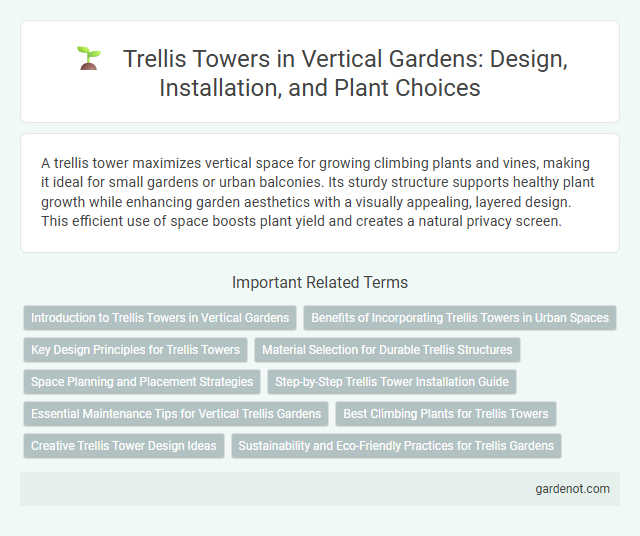A trellis tower maximizes vertical space for growing climbing plants and vines, making it ideal for small gardens or urban balconies. Its sturdy structure supports healthy plant growth while enhancing garden aesthetics with a visually appealing, layered design. This efficient use of space boosts plant yield and creates a natural privacy screen.
Introduction to Trellis Towers in Vertical Gardens
Trellis towers in vertical gardens maximize space by providing vertical support for climbing plants such as ivy, tomatoes, or beans, enhancing both aesthetics and yield. These structures are typically made from durable materials like wood, metal, or composite, designed to withstand weather conditions while promoting healthy plant growth through improved air circulation and sunlight exposure. Incorporating trellis towers optimizes urban gardening by enabling efficient use of limited ground space and creating living green walls that contribute to air purification and biodiversity.
Benefits of Incorporating Trellis Towers in Urban Spaces
Trellis towers maximize vertical green space in urban areas by supporting climbing plants, which enhance air quality and reduce heat island effects. Their modular design allows for efficient use of limited space, promoting biodiversity and improving aesthetics in densely populated environments. Incorporating trellis towers also aids in noise reduction and provides natural insulation, contributing to sustainable city living.
Key Design Principles for Trellis Towers
Trellis towers in vertical gardens prioritize structural stability and modularity to support climbing plants effectively while maximizing vertical space. They incorporate durable, weather-resistant materials and optimize airflow and light exposure to promote healthy plant growth. Precise spacing and anchoring systems ensure easy maintenance and adaptability for various plant species.
Material Selection for Durable Trellis Structures
Selecting corrosion-resistant materials like galvanized steel or powder-coated aluminum enhances the longevity of trellis towers in vertical gardens. Using weatherproof wood such as cedar or teak offers natural durability while maintaining aesthetic appeal. Incorporating UV-resistant coatings and rust-proof fasteners further ensures structural integrity and sustained performance in outdoor environments.
Space Planning and Placement Strategies
The Trellis Tower vertical garden maximizes space efficiency by utilizing vertical growth to create lush green walls within compact areas. Strategic placement near natural light sources and against sturdy structures ensures optimal plant health and stability. Integrating the Trellis Tower into corners or narrow walkways enhances spatial planning while maintaining aesthetic appeal and accessibility.
Step-by-Step Trellis Tower Installation Guide
Start your trellis tower installation by selecting a sturdy base and securing it firmly into the ground to ensure stability. Assemble the vertical frame using weather-resistant materials like treated wood or metal, attaching cross braces at regular intervals for added support. Finish by training climbing plants onto the trellis, tying them gently to encourage upward growth and maximize vertical garden space efficiently.
Essential Maintenance Tips for Vertical Trellis Gardens
Regularly inspect the trellis tower for structural integrity to ensure support for climbing plants and prevent damage from heavy foliage. Prune plants to encourage healthy growth and prevent overcrowding, which can obstruct sunlight and air circulation. Clean the trellis surface to remove dirt, algae, and pests that may compromise plant health and the tower's longevity.
Best Climbing Plants for Trellis Towers
Trellis towers provide ideal vertical support for climbing plants such as clematis, honeysuckle, and jasmine, which thrive in well-drained soil with ample sunlight. Fast-growing vines like morning glory and sweet pea are also excellent choices for quickly covering trellis structures, enhancing both aesthetics and privacy. Selecting disease-resistant varieties ensures longevity and a vibrant, healthy vertical garden that maximizes space efficiently.
Creative Trellis Tower Design Ideas
Innovative trellis tower designs transform vertical gardens into dynamic living art installations by incorporating modular components and varying geometric shapes to maximize plant growth and aesthetic appeal. Integrating materials like reclaimed wood, metal mesh, and biodegradable fibers enhances sustainability while providing structural support for climbing plants such as ivy, jasmine, and tomatoes. Creative lighting solutions and automated irrigation systems further optimize plant health and create visually striking displays suitable for urban balconies and small outdoor spaces.
Sustainability and Eco-Friendly Practices for Trellis Gardens
Trellis towers in vertical gardens promote sustainability by maximizing green space usage in urban environments, reducing the need for land expansion. Constructed from recycled or renewable materials, these structures minimize environmental impact while supporting plant growth that improves air quality and biodiversity. Integrating water-efficient irrigation and organic cultivation methods further ensures eco-friendly practices in trellis garden management.
Trellis tower Infographic

 gardenot.com
gardenot.com